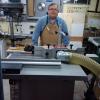Historically Iíve been beholden to the lumber retailer for whatever thickness he had available. That usually meant 4/4 rough sawn or 3/4 S4S. Thatís rather stout for smaller scale projects and planing half of it away seemed a terrible waste of time, money, and good lumber. Dimension lumber in 1/4 and 3/8 thicknesses was stupid expensive and rarely straight.
Since I acquired my Rikon bandsaw this past summer, Iíve been experimenting with resawing. What a game changer. Iíve resawn 4/4 and 3/4 stock so far and had excellent results both times. I enjoy making boxes and other smaller scale projects, and the thinner stock is much easier to work with and more appropriate for scale. Bookmatching and grain wrapping is simple. Lumber just got much more economical too.





 Reply With Quote
Reply With Quote





 I resawed a 16” wide piece of ash recently, took about 20 seconds. That would be a mountain to climb by hand.
I resawed a 16” wide piece of ash recently, took about 20 seconds. That would be a mountain to climb by hand.



